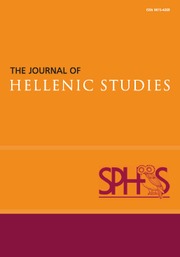Materiality and Aesthetics in Archaic and Classical Greek Poetry is a book about poikilia, a concept that can mean ‘embroidery, variegation, versatility’ or other denotations of beguiling complexity. Amy Lather argues that the concept does two basic things. It marks media, such as textiles, armour or body language, as visually engrossing. This is how the term has been most traditionally understood. More importantly, poikilia also signals moments of engagement with materiality, when the boundaries between mind, body and things temporarily blur: the vivid ekphrasis of Achilles’ shield where metal figures move; Prometheus’s fennel stalk of fire reshaping matter through his poikilos cunning; Aphrodite’s wondrous girdle that ensnares the senses of Zeus. The family of nouns, adjectives and verbs with the root poikil- (< IE *peiḱ ‘stitch, paint’) conveys ‘elaborate decoration as well as the myriad effects generated by this quality’ (198) and thus is supremely potent for exploring Greek aesthetics. Lather’s book, the first in Edinburgh University Press’ new series Ancient Cultures, New Materialisms, is a welcome study of the materials and characters tagged with the term and will be a benefit to students and researchers of the way Greek texts convey material experience.
The book sorts media marked as poikilos into six chapters, each informed by theoretical insights from New Materialism and cognitive aesthetics. After a theory-rich introduction, Chapter 1 surveys what is poikilos about textiles as represented in literature, Acropolis kourai and vase painting. Such woven cloth engages the senses through diverse patterning that relates the impressive mind and body of the weaver in a way similar to Alfred Gell’s notion of the ‘technology of enchantment’ (‘The Technology of Enchantment and the Enchantment of Technology’, in J. Coote and A. Shelton (eds), Anthropology, Art and Aesthetics (Oxford 1992) 40–63) or Alva Noë’s ‘enactive perception’ (Action in Perception (Cambridge MA 2004). Chapter 2 treats the ‘vitality’ (via Jane Bennett) of armour in its various agentive and sensory capacities. Armour shines, resounds and is lively enough to be embodied by heroes themselves, such as Hektor when he ‘blazes with fire’ in Iliad 15. Chapter 3 applies Bill Brown’s ‘thing theory’ (‘Thing Theory’, Critical Enquiry 28 (2001) 1–16) and Andy Clarks’ ‘extended mind’ (Andy Clark and David Chalmers, ‘Extended Mind’, Analysis 58 (1998) 7–19) to animated objects, such as Hephaestus’ automata of Iliad 18 or Pandora in Hesiod, whereby what is spectacular about them is both their technical intricacy and their ‘excessive’ capabilities to enact the minds of their creators. Chapter 4 looks at poikilia’s contribution to lyric pleasure and metacognition in Sappho, Alcaeus, Anacreon and Pindar. Chapter 5 shifts to the characters of Hermes, Prometheus and Odysseus, who are all distinguished as poikilomētēs (‘someone with various cunning’) and manipulate the material world and physical appearance as extensions of their thinking. Chapter 6 returns to gendered aspects of the term, specifically the synergy between the effects of poikilia and how texts construct ‘feminine guile’. The conclusion finds even in Plato’s negative valence (variegated things produce adulterated souls) testaments to the term’s enmeshing of material and mind.
This combination of literary, theoretical and media-focused approaches results in a wide array of tantalizing analyses at times as compelling as the objects they scrutinize. Such a method ventures away from strict philological study of the concept, a strategy that will likely attract readers of various literary disciplines, but at times might frustrate those interested in the terms’ contextual semantics. The book takes for granted that media designated as poikilos are such intrinsically even in instances where the term is absent (especially for textiles, armour and smart objects). Why, for instance, is the robe of Andromache described as poikilos in Iliad 22, but Helen’s in book 3, which by all accounts seems more engaging, is not? Future work could incorporate narrative and structural contexts more fulsomely. That said, this media-centred reading is effective and does much to illuminate how poikilia invited audiences to imagine things beyond their decorative features and into the stuff of who we are.

